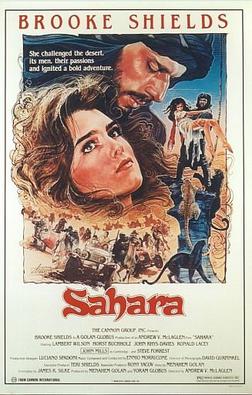 The year is 1927 and famed automobile designer R.J. Gordon (Steve Forrest) dies before he can enter his latest creation into the Trans-African Auto Race across the Sahara Desert. Wishing to keep her father’s dream alive and prove that she’s just as good a driver as the boys, R.J.’s daughter, Dale (Brooke Shields), enters the race in his place. Since women are not legally allowed to compete, Dale has to pretend to be a man. She does this by wearing a fake mustache, which she tosses off as soon she drives over the start line. It has to be seen to be believed.
The year is 1927 and famed automobile designer R.J. Gordon (Steve Forrest) dies before he can enter his latest creation into the Trans-African Auto Race across the Sahara Desert. Wishing to keep her father’s dream alive and prove that she’s just as good a driver as the boys, R.J.’s daughter, Dale (Brooke Shields), enters the race in his place. Since women are not legally allowed to compete, Dale has to pretend to be a man. She does this by wearing a fake mustache, which she tosses off as soon she drives over the start line. It has to be seen to be believed.
Dale and her team set out on the race and they quickly get caught up in a tribal war between two separate factions of Bedouins. Dale is captured by the lascivious Rasoul (John Rhys-Davies), who attempts to have his way with her. Fortunately, Dale is rescued by Rasoul’s nephew, Sheikh Jafar (Lambert Wilson). Jafar is enchanted by Dale’s beauty and wants her to marry him. Dale eventually agrees but, the morning after the wedding, she sneaks out of Jafar’s tent, jumps back in her car, and rejoins the race. When she gets captured by the other Bedouins, they force her to stand on a rock while surrounded by panthers. Like Brooke with a mustache, it has to be seen to be believed.
Sahara was produced by Cannon Pictures. Menahem Golan, who gets a story credit along with his usual producers credit on this film, was a self-described fan of Rudolph Valentino and Sahara was his attempt to pay homage to Valentino’s performance in The Sheik, as well as cashing in on the adventure zeitgeist that had been launched by the box office success of Raiders of the Lost Ark. With a budget of $15 million, Sahara was one of Cannon’s most expensive films and the end result was a mix of high production values and typical Golan-Globus goofiness. The desert cinematography may be impressive but this is still a strangely old-fashioned movie starring Brooke Shields as a race car driver who speeds through the desert without once getting a hair out of place. As attractive as she was, Brooke was never much of an actress and requiring her to show more than one emotion at a time, as Sahara often does, seems like the ultimate act of hubris. Say what you will about the films that Cannon made with Bronson and Norris, the two Chucks always seemed like they were perfectly cast. Shields also has no chemistry with Lambert Wilson, who looks embarrassed at having to pretend to be Rudolph Valentino. On the plus side, Raiders of the Lost Ark alumni Rhys-Davies and Ronald Lacey are both present in the film and seem to know better than to take any of it seriously. Rhys-Davies especially always seems to be on the verge of laughing at his terrible dialogue.
Though the view may be impressive, the script is bad and the lead actors are lost. Avoid Sahara at all costs.

